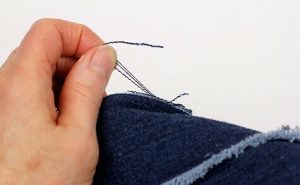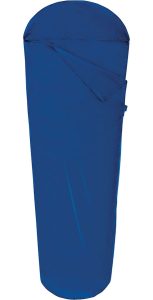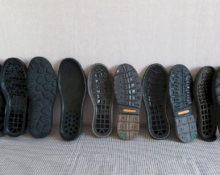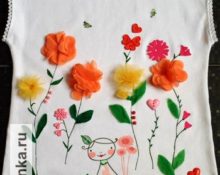
fair.ua
What are sleeping bag inserts used for?
This simple design solves several problems at once:
- Hygienic – protects the sleeping bag from dirt and sweat.
- Thermal insulation – warm liners significantly increase the thermal insulation of a sleeping bag.
Structurally, the liners differ in shape and repeat the shape of the sleeping bag for which they are sewn.
There are rectangular liners and cocoon liners that taper towards the feet.
Fabrics for sewing a sleeping bag liner:
To choose fabric for the liner, you need to decide what time of year you plan to sew it for.
- Fleece liner - for cold weather. Has the highest thermal insulation. Its disadvantage is its large volume and weight of 500-600 grams;
- Polartek – used for sewing thermal underwear. When using it, the temperature inside the sleeping bag will increase by 20-30%;
- Cotton liner - rather serves hygienic purposes, because... It is easy to wash, perfectly absorbs moisture, and its weight is only 300-400 g.
- Silk liner is a summer option. Its weight is minimal (160 grams), but this fabric is quite difficult to work with and is more expensive than others.
How to sew a sleeping bag liner with your own hands
- Place the pattern paper on the floor. She is wearing a zipped sleeping bag. Trace its outlines with a pencil. Mark the neck line from which the hood will begin.
- Cut out the resulting pattern along with the hood - this will be the back part of the sleeping bag liner.
- Cut the front part without taking into account the hood.
- Baste the product and then sew it, finishing the edges with a zigzag so that they do not fray.
How to sew a sleeping bag for a hike with your own hands
Today, a sleeping bag is an indispensable thing for a tourist. And it is quite possible to sew it with your own hands.
In its design, a sleeping bag is similar to a two-layer tent, in which:
- The outer fabric is water-repellent;
- Inner - cotton (poplin, calico, satin...);
- The middle part is padding polyester, fleece, holofiber or just a wool blanket.
In addition to a set of fabric, you will need a metal zipper and nylon threads.
Sleeping bags can be of several types:
- A blanket sleeping bag is the simplest model. It is sewn from a blanket, along the edges of which a zipper is attached. Ideal for a short hike.
- Envelope - to sew it you need two types of fabric:
— outer layer – synthetic with water-repellent impregnation;
- internal - cotton and metal zipper from 100 cm long.
- The cocoon differs from the previous version in that its width becomes narrower towards the legs, and the hood is tightened with a cord with a lock.
How to insulate a sleeping bag
To insulate sleeping bags, artificial and natural insulation is used.
Artificial - padding polyester, holofiber, etc. Natural - down of waterfowl.
If you decide to use down, the outer fabric for the sleeping bag should be made of down-proof material (calendered nylon), and the inner fabric should be thick cotton fabric.
How to fold a sleeping bag into a cover
To carry a sleeping bag and store it more compactly, special covers are used. The addition rules are very simple:
- First of all, you need to fasten the sleeping bag and carefully straighten it;
- Fold it in half;
- Choose the narrow side and, starting from it, twist the sleeping bag as tightly as possible;
- Place in a case.
Sleeping bags are used not only for hiking trips. By analogy, you can make an in-cab sleeping bag with your own hands, where the driver can sleep on the road.
You can also sew a sleeping bag for the roof with your own hands, based on the recommendations outlined above.
Sometimes a condenser is used to protect a sleeping bag. This is a large cover that fits over the sleeping bag to protect it from icing or as protection from wind and morning dew when spending the night under a tent.
How to sew underarmor
Underarmor is a thin, quilted caftan used to fit under armor. It is quite possible to sew it with your own hands. Let's look at how to make underarmor with a stand-up collar, detachable sleeves and a tie on the chest. Consists of 3 layers. We choose linen as the main fabric, the lining is calico or flannel. For stuffing it is better to use batting or padding polyester.
Scheme of work:

fair.ua
- Create a pattern for the product;
- Cut out the parts with a margin of 2-3 cm. Fold the wrong side with the face, with stuffing between them. Secure with pins;
- Quilt the parts vertically;
- Sew the back along the seam, and sew the front halves to it. Sew the shoulder line. Seal the cuts;
- By analogy, sew both sleeves;
- Make a paper pattern for a collar, 4-6 cm high. Place it on the fabric and cut it out. Quilt and stitch;
- On the front parts, punch holes in pairs with a distance of 2-3 cm and a pitch of 6-10 cm. Hem the edges of the holes;
- The laces are made of thin leather or suede. Length 20-30 cm.
DIY bed bag
You can make not only sleeping bags, but also frameless furniture with your own hands. A bean bag or bean bag chair is a cover made of thick fabric, which is filled 2/3 of the volume with foam balls. Making them is also not difficult. Such furniture is now very popular in all countries of the world.


 0
0





